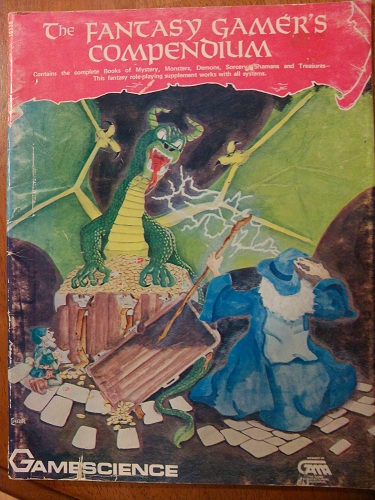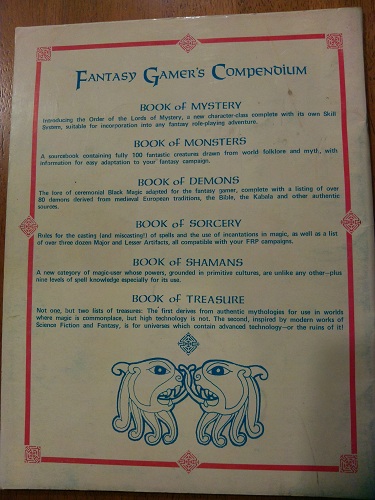Oddities from My Bookshelf – The Fantasy Gamer’s Compendium
Back in the early 1980’s, there was no Open Gaming License. If anyone wanted to publish a sourcebook for Advanced Dungeons and Dragons, they had to license it with TSR.
Well, in theory, anyway.
In practice, third-party companies put out game products that were plainly intended to be used with Dungeons and Dragons, but never mentioned the name, TSR or anything specific. They simply called their products source material for “fantasy games.” Sure, in theory Grimtooth’s trap series could have been used in Runequest, Arduin, or Tunnels and Trolls (which were pretty much the only other games in town). But some products, not so much.
Enter The Fantasy Gamer’s Compendium, published by Gamescience back in 1983. Well, that makes it sound as though this product had some major impact on the market. It didn’t. It was one product in a larger third-party market. I have two copies for some reason (though one copy does have a printing error through the middle twenty pages or so), and I think I found it (them, I guess) at a Pacificon flea market sometime in the mid-to-late 80’s.
I found a lot of small, cool books and games that way.
This one is broken down into six sections: (I’ve marked with asterisks the sections designed specifically, in my opinion, to be used with D&D. You can tell by details like the class experience charts, which match the style and format from the D&D Player’s Handbook.)
- Book of Mystery* – this is a new class. Characters can play members of a secret society, developing sets of skills that might make them possible alternatives to thieves. If you don’t mind thieves who can learn healing skills.
- Book of Monsters – this one is cool. They go through myths and folklore all over the world and cull out monsters. These include qiqirn (Eskimo), ahuizotl (Aztec), and con tram nu’o’c (Vietnamese). They give one paragraph descriptions, then provide a chart that covers comparisons to existing game creature categories (e.g. Class 4 protection is equivalent to Scales, plates or chainmail armor). I didn’t fact-check their research, but it’s not a bad way to pick up some quick, unexpected monsters.
- Book of Demons* – this is a new class and more. The class is intended to represent old-school demon summoning sorcerers, with their own detailed system of conjuration and casting. Then they take it a step further – they give you demons (with attributes) taken from actual real-world books like the Key of Solomon and the Grand Grimoire.
- Book of Sorcery* – this is practically a supplement for AD&D wizards. It includes rules for playing a zero-level apprentice, more magic items and artifacts, and four-line incantations to go with AD&D spells. Example:
Invisible Stalker
Come forth from magic planes I call
A servant to fulfill my need
Invisible, you are my thrall
To do my will you shall proceed
- Book of Shamans* – this is a straightforward new class, representing the classical idea of shamanism. This one even has a bibliography that even includes Mircea Eliade and J.G. Frazier.
- Book of Treasure – I’m particularly fond of this one. They combed through a variety of myths and folktales to bring together all kinds of magic items, from obvious ones like Bran’s Cauldron (Irish) to more obscure choices like akpou (African). It even goes on to list magic items derived from tech (I consider that a questionable choice, but some people are into it).
On the whole, a fun little book, or at least enjoyable enough that I bought it twice.



